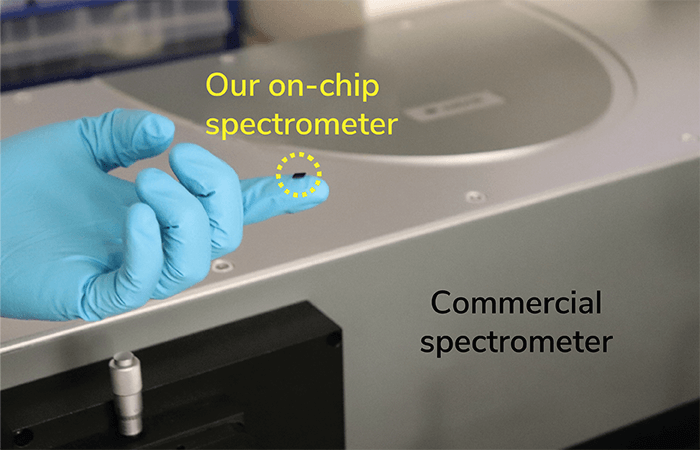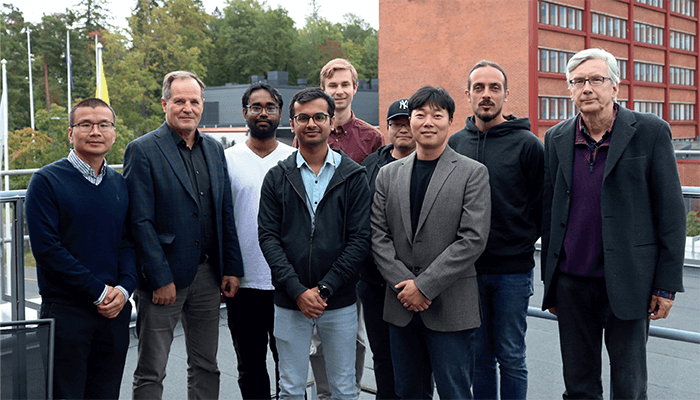The components used in traditional spectrometers to filter and disperse light take up space, limiting the potential to miniaturize the technology and open the door to applications that demand total mobility.
And that’s why researchers from Aalto University, Finland, designed a spectrometer that fits on a microchip. But it’s not just small – the team were able to achieve a performance comparable to benchtop systems, replacing certain key components with novel semiconductor materials and using the power of artificial intelligence (AI). Here, we interview Hoon Hahn Yoon, first author of the study, to find out more.

Tell us about your ultra-mini spectrometer...
We’re proud to say we’ve designed a miniaturized spectrometer that breaks all current resolution records – in an ultra-tiny footprint of 22 μm by 8 μm. To do so, we replaced optical and mechanical components with a combination of AI algorithm and the electrically tunable sensor’s spectral response – eliminating the need for detector arrays, dispersive components, and filters. We hope that this all-in-one, miniaturized device will revolutionize the field, enabling portable, low-cost, high-performance spectrometers.
What makes this so interesting is that it offers performance comparable to benchtop systems – whilst being thousands of times smaller than those same commercial systems. In other words, these new spectrometers will provide portable alternatives to uncover otherwise invisible information without even going into the lab.
The device is also entirely electrically controllable, so it has enormous potential for scalability and integration. For example, it could give us a next generation of smartphone cameras with hyperspectral capability.

Which areas will benefit most from this technology?
By integrating on-chip spectrometers into portable devices, such as smartphones and drones, we could open up a whole host of analytical possibilities in quality inspection, security, biomedical analyzers, environmental monitoring tools, and space telescopes. To give you a concrete example, people with food allergies could verify their food is safe. Such devices could also enable monitoring of crop health, pollution, food quality, and even the progression of some diseases.
What do these findings mean for the future of spectroscopy?
Ultra-miniaturization is definitely the way forward. Our spectrometers offer high performance with high wavelength accuracy, high spectral resolution, and broad operation bandwidth, using only a single microchip-sized detector in ambient conditions.
Until now, there has been a trade-off between spectrometer performance and size because traditional systems use light dispersion over distances or spectral filter and detector arrays to achieve a high resolution. Our technology eliminates this trade-off, making portable, low-cost, high-performance spectrometers a reality.

Can further improvements be made?
We are expanding our work to improve spectrometer performance and further fit complementary metal-oxide semiconductor (CMOS) compatible technology. More advanced AI or machine learning algorithms and different combinations of materials could soon provide even better spectrometers.
We used the van der Waals heterostructure by stacking two-dimensional materials. Since these are so-called emergent materials, there is still room for engineering advances in their large-area synthesis, uniformity, and yield. Our idea can also combine with any emergent optoelectronic devices other than two-dimensional materials. There are numerous promising candidates for the material platform to realize our demonstration with better performance.
Furthermore, if a semiconductor foundry company, such as Samsung Electronics, wants to implement our spectrometer technology into their own products – such as smartphones or drones – I expect that it might take only a few years. The chip fabrication technology used for our miniaturized spectrometer belongs to the basic foundry technology widely used in the semiconductor industry. Thus, there are no fundamental barriers to overcome for commercialization.
Overall, I am excited about what the future holds – hopefully it will link to the future of next-generation smartphone cameras evolving from conventional color cameras to hyperspectral cameras!
References
- HH Yoon et al., “Miniaturized spectrometers with a tunable van der Waals junction,” Science, 378, 296 (2022). DOI: 10.1126/science.add8544



